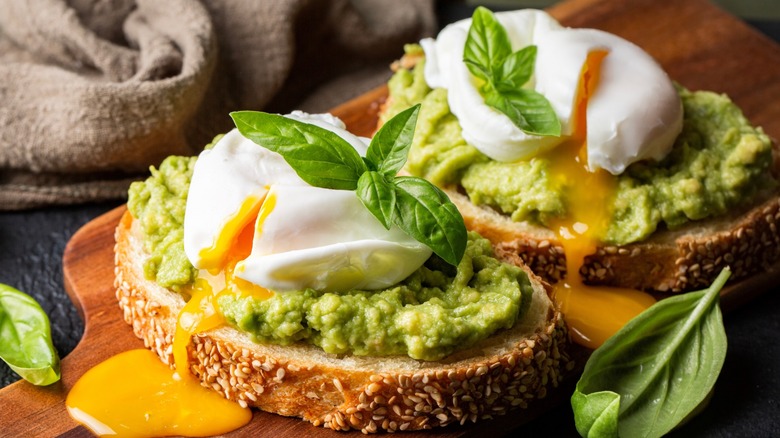Poached Eggs: To Stir Or Not To Stir?
One of the biggest cooking debates used to be whether cilantro tasted good or not. Now, prepare yourself for an even larger form of discourse — the poached egg debate. Many home cooks and industry professionals initially believed there was only one way to prepare a poached egg and swore by this particular method. This traditional technique involves a pot of swirling water and stirring a cracked egg until it forms into a solid with a runny center.
However, now people are coming out of the woodwork decrying swirling poached eggs. Though a spiraling vortex was once the height of poached egg technology, some at-home chefs have found other ways to make eggs Benedict for brunch like using vinegar, poach pods, or even the microwave. Whether the stirring occurs before or during the creation of the poached egg, the whirlpool strategy is certainly a more classic approach. But now the question remains: Is it better to stir or not to stir?
The argument for stirring poached eggs
Ask most industry professionals and they are likely to tell you that creating a vortex of water is the ideal approach to poaching eggs. The creation of this delightful dish isn't as cut and dry as scrambled eggs, which still have varying techniques for cooking that people forget about. However, once you have mastered it, you are that much closer to a delectable breakfast.
This process starts by boiling the water. When hot enough, you create a swirling motion and quickly place the raw egg in the liquid. The whirlpool wraps the egg white around the yolk as it cooks, leaving you with it being perfectly cooked. The only tricky part about this is getting your spiral right and making sure you take it out at the right time.
Martha Stewart notes that this method helps to keep the shape of the egg perfectly intact, which she likes to put on toast with tomato, cream cheese, spinach, and garlic. The Pioneer Woman, Ree Drummond, agrees that using the stirring strategy is ideal because the "circular motion creates a tornado effect that helps keep the egg white from spreading out too much."
The argument for not stirring poached eggs
Alton Brown advises in a video for the Food Network that if you are attempting to poach many eggs at once, there is a better way. Instead of stirring, his recipe calls for salt and white vinegar. After dosing the water with the mixture, add the eggs, cover, and do not stir for about seven minutes. This will leave you with a nice consistency, though they might not look as uniform in shape as the stirred version.
For those less concerned with chef-approved strategies, there is another way. Poach pods are exactly how they sound. Place an egg in its designated container and let simmer in hot water. Cover with a lid for a few minutes and serve when ready. The only downside of this technique is that it would require a large and shallow pot to hold multiple devices at the same time.
Circumventing the stove altogether, some have found a way to accomplish a poached egg in a microwave. You won't find this trickery in any fine dining restaurants but it functions just as a stove does. Just pop a raw egg in a ramekin with some water and microwave it. The only issue with this technique is that you should check it every 10 seconds to make sure it's properly cooked.
Ultimately, which approach you use will likely come down to how concerned you are about what they look like and how much time you have.


